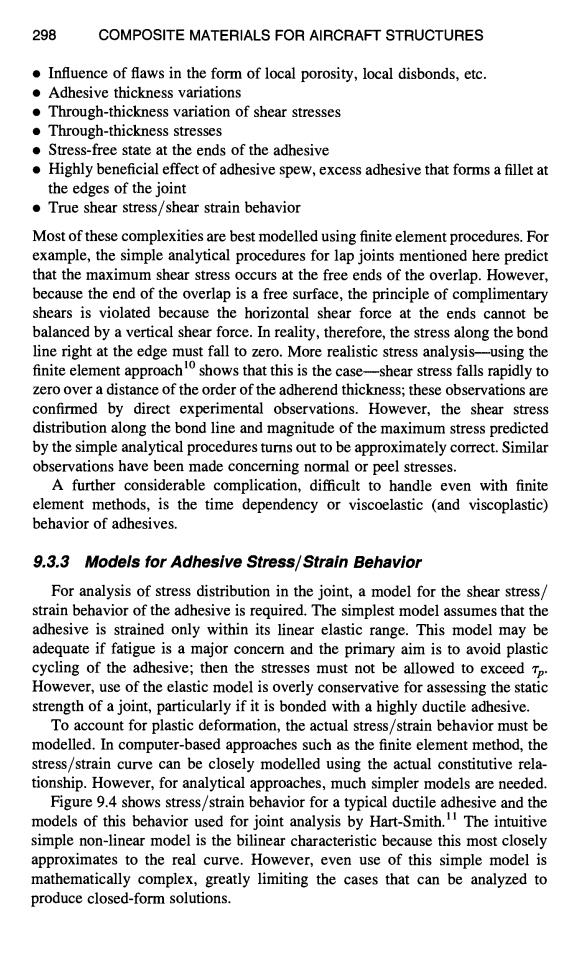正在加载图片...

298 COMPOSITE MATERIALS FOR AIRCRAFT STRUCTURES Influence of flaws in the form of local porosity,local disbonds,etc. Adhesive thickness variations .Through-thickness variation of shear stresses Through-thickness stresses .Stress-free state at the ends of the adhesive .Highly beneficial effect of adhesive spew,excess adhesive that forms a fillet at the edges of the joint True shear stress/shear strain behavior Most of these complexities are best modelled using finite element procedures.For example,the simple analytical procedures for lap joints mentioned here predict that the maximum shear stress occurs at the free ends of the overlap.However, because the end of the overlap is a free surface,the principle of complimentary shears is violated because the horizontal shear force at the ends cannot be balanced by a vertical shear force.In reality,therefore,the stress along the bond line right at the edge must fall to zero.More realistic stress analysis-using the finite element approach shows that this is the case-shear stress falls rapidly to zero over a distance of the order of the adherend thickness;these observations are confirmed by direct experimental observations.However,the shear stress distribution along the bond line and magnitude of the maximum stress predicted by the simple analytical procedures turns out to be approximately correct.Similar observations have been made concerning normal or peel stresses. A further considerable complication,difficult to handle even with finite element methods,is the time dependency or viscoelastic (and viscoplastic) behavior of adhesives. 9.3.3 Models for Adhesive Stress/Strain Behavior For analysis of stress distribution in the joint,a model for the shear stress/ strain behavior of the adhesive is required.The simplest model assumes that the adhesive is strained only within its linear elastic range.This model may be adequate if fatigue is a major concern and the primary aim is to avoid plastic cycling of the adhesive;then the stresses must not be allowed to exceed Tp. However,use of the elastic model is overly conservative for assessing the static strength of a joint,particularly if it is bonded with a highly ductile adhesive. To account for plastic deformation,the actual stress/strain behavior must be modelled.In computer-based approaches such as the finite element method,the stress/strain curve can be closely modelled using the actual constitutive rela- tionship.However,for analytical approaches,much simpler models are needed. Figure 9.4 shows stress/strain behavior for a typical ductile adhesive and the models of this behavior used for joint analysis by Hart-Smith.The intuitive simple non-linear model is the bilinear characteristic because this most closely approximates to the real curve.However,even use of this simple model is mathematically complex,greatly limiting the cases that can be analyzed to produce closed-form solutions.298 COMPOSITE MATERIALS FOR AIRCRAFT STRUCTURES • Influence of flaws in the form of local porosity, local disbonds, etc. • Adhesive thickness variations • Through-thickness variation of shear stresses • Through-thickness stresses • Stress-free state at the ends of the adhesive • Highly beneficial effect of adhesive spew, excess adhesive that forms a fillet at the edges of the joint • True shear stress/shear strain behavior Most of these complexities are best modelled using finite element procedures. For example, the simple analytical procedures for lap joints mentioned here predict that the maximum shear stress occurs at the free ends of the overlap. However, because the end of the overlap is a free surface, the principle of complimentary shears is violated because the horizontal shear force at the ends cannot be balanced by a vertical shear force. In reality, therefore, the stress along the bond line right at the edge must fall to zero. More realistic stress analysis--using the finite element approach 1° shows that this is the case--shear stress falls rapidly to zero over a distance of the order of the adherend thickness; these observations are confirmed by direct experimental observations. However, the shear stress distribution along the bond line and magnitude of the maximum stress predicted by the simple analytical procedures turns out to be approximately correct. Similar observations have been made concerning normal or peel stresses. A further considerable complication, difficult to handle even with finite element methods, is the time dependency or viscoelastic (and viscoplastic) behavior of adhesives. 9.3.3 Models for Adhesive Stress/Strain Behavior For analysis of stress distribution in the joint, a model for the shear stress/ strain behavior of the adhesive is required. The simplest model assumes that the adhesive is strained only within its linear elastic range. This model may be adequate if fatigue is a major concem and the primary aim is to avoid plastic cycling of the adhesive; then the stresses must not be allowed to exceed "rp. However, use of the elastic model is overly conservative for assessing the static strength of a joint, particularly if it is bonded with a highly ductile adhesive. To account for plastic deformation, the actual stress/strain behavior must be modelled. In computer-based approaches such as the finite element method, the stress/strain curve can be closely modelled using the actual constitutive relationship. However, for analytical approaches, much simpler models are needed. Figure 9.4 shows stress/strain behavior for a typical ductile adhesive and the models of this behavior used for joint analysis by Hart-Smith. 11 The intuitive simple non-linear model is the bilinear characteristic because this most closely approximates to the real curve. However, even use of this simple model is mathematically complex, greatly limiting the cases that can be analyzed to produce closed-form solutions